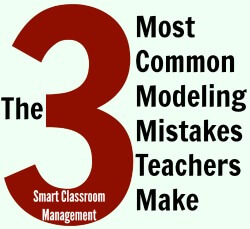Whether you’re teaching your students how to enter the classroom in the morning, turn in work, circle into groups, or even how to sit and attend during lessons, modeling is the most effective and efficient way to do it.
 Yet, it’s an area many teachers struggle with.
Yet, it’s an area many teachers struggle with.
The truth is, your ability to model what you want and expect from your students in large part determines your success.
So it’s important that you’re good at it, that you’re able to model in a way your students can understand and perform with excellence.
Too often teachers assume that their students are the problem, that the reason they don’t follow routines or directions very well is because they’re not listening or paying attention.
But more often than not, the real problem is that the teacher is making one or more of the following three modeling mistakes.
1. Not providing enough detail.
Few teachers model with the level of explicitness needed to immerse students in the instruction. They tend to gloss over critical details, rely on too much talk and hand gestures, and make assumptions about what students should already know and understand.
But good modelers assume nothing.
They play-act every step from start to finish. They even add amusing, inconsequential steps to help students create richer mental pictures and memory maps. Good modelers also have the ability to put themselves in their students’ shoes, vicariously viewing their instruction from a student’s perspective.
They model from student desks, model using student materials, and model as if they were an actual member of the class. They capitalize on the universal desire for students to see with their own eyes what is expected of them—so there are no mysteries or uncertainties, and nothing left uncovered.
2. Having a negative vibe.
Teachers tend to get grumpy when modeling routines and directions. They take on a serious, even ominous, tone, believing that students are more apt to pay attention and do what is asked if there is an implied threat to the instruction.
Add more details to the mix and your expectations can appear militaristic or mindlessly robotic, which discourages rather than encourages attentiveness, motivation, and good performance. To be most effective, modeling should never feel like drudgery.
On the contrary, it should be sprinkled with humor, lightheartedness, and a spirit of teamwork. Your enjoyment teaching routines and directions rubs off on students, who are then better able to recall each step along the way and eager to show you how well they can perform them.
3. Accepting less than what was modeled.
Of the three, this mistake is the most detrimental. Regardless of what it is, if you model something for your students, it’s critical you make sure it’s performed as modeled. If ever you get in the habit of accepting less than your original expectation, then eventually you’ll lose control of your class.
Routines in particular are the most susceptible to this gradual but certain faltering of standards. And what makes this mistake so insidious is that sloppiness and an uncaring attitude will transfer to everything you do.
When stressed-out teachers email us here at SCM desperate for answers, accepting ‘good enough’ is often the culprit.
Therefore, once your students prove they can perform a routine as modeled, then that must be the expectation until the last minute of the last day of school. But here’s the thing: Once you prove that you’ll respond with action for every time they stray from your standards, they’ll stop straying from them.
It’s All Teaching
Many teachers are quick to admit their dislike for modeling routines, procedures, and mundane directions. But it’s all teaching. Whether it’s solving algebraic equations, writing persuasive essays, or showing your students how to put away their backpacks, it’s all teaching.
And it’s all good.
The most successful teachers embrace the common and everyday as well as the intellectually stimulating. Going through the motions, coaxing students through poorly followed directions, accepting less than what you want and know is best for your class . . .
All are guaranteed to come back and haunt you.
Learn to love modeling; to love the beauty of a job well done, the simple, quiet satisfaction of good teaching, and the peace of mind that comes with knowing your students will do as you ask.
If you haven’t done so already, please join us. It’s free! Click here and begin receiving classroom management articles like this one in your email box every week.

I agree with the author that step 3 is often the step that is ignored and not retaught. I feel this can often be due to time contraints.
This article had a lot of good tips. I am guilty of just assuming that my students will know what is expected. I truly like the idea of modeling for them as if I was the student.
I feel the modeling is a grate idea, even better if you can do it with laughter and get the students in on it. i’m thinking of having students getting into small groups and coming up with skits based on rules, and procedures of the classroom. Some showing the right way and others showing the wrong way to do things. After each skit , the class will say if its a right or wrong procedure.
When I have 99% of the children following my expectations and those one or two sabotage it for the class, then should I have to repeat the modeling and practice for those one or two.
Hi tccarter,
No, just hold those particular students accountable by following your classroom management plan.
Michael